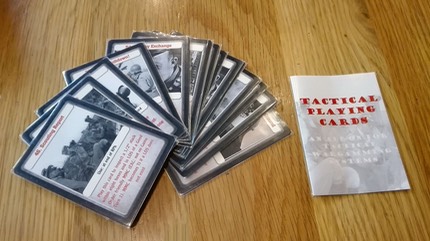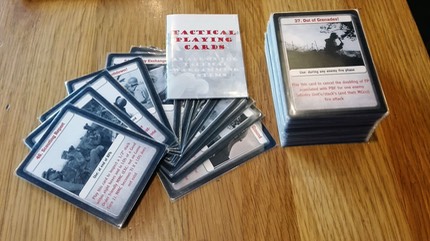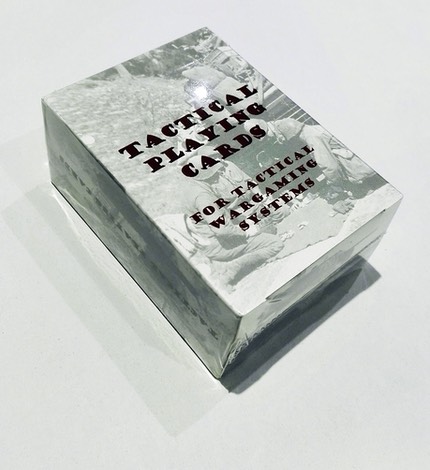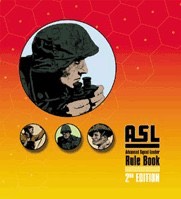
What?
A deck of "Tactical Playing Cards" (or T-cards) to use when playing an ASL scenario.
Why?
It introduces an add-on to the game, which hopefully should add extra fun without being onerous for players.
How?
Each player receives at game start a number of cards from the deck and may play them whenever he sees fit during a scenario. Each card has an effect printed on it, just apply what is written on the card and discard the card. The total number of cards in the deck is sufficiently large to ensure that no hand will be similar to another. The rules underpinning T-cards' use are as concise as possible. A mini tournament was organised during the ASLOK tournament using the Tactical Playing Cards.
What does it look like?
The cards follow the standard for collectible cards (poker-sized, 300 grams/sm). There is 108 cards featuring 69 different events; 1 color tuck box; 1 four-page booklet.
With which scenarios is it compatible?
Almost all of them. No card requires little-used rules from the ASLRB and most cards draw their inspiration from Chapter A rules.
Any requirements?
Players with 40+ games under their belt would be comfortable with the text of the cards. Designed as they are, the cards should not distract the player from scenario action.
Who will be interested?
- those who like to try new products with their regular ASL buddy;
- those who want to spice up vanilla scenarios;
- those who want to introduce an additional dimension to ASL games.
The cost for the Tactical Playing Cards is only EUR 30, and that includes shipping!
The cards are currently available only to countries in Europe. To order these, they are located in the "Other Third Party" section in the Webshop.

Initial allocation of cards: an example
Players A and B choose to play a 6-turn scenario of moderate size.
The allocation of cards follows a three-step process.
Step 1: They each get 6 cards from the deck.
Step 2: Each player chooses to keep 2 cards hidden from the opponent. The other cards are revealed and merged to form a Joint Card Pool in view of both players. In this example the Joint Card Pool will be 8-card strong (4 from each player).
Step 3: Then players start picking cards from the Joint Card Pool. Determine randomly who start. Player A wins the toss and picks a first card. Then player B will pick the second and third cards. Player A the fourth and fifth card etc... (a-b-b-a pattern) until the Joint Card Pool is exhausted.
Eventually each player ends up with 2 hidden cards from their opponent and four cards visible from their opponent.
The procedure ensures:
- fairness in card allocation
- better adequacy of cards to each player's perceived needs (attack, defense, infantry, vehicular, etc.)
- fog of war is preserved by keeping two (possibly strong) cards hidden until played, while avoiding too much card manipulation during the game (flipping cards upside down etc.)
Further comments around T-cards
Drafting card text is tricky, as always when dealing with ASL rules. The cards should be clear yet without loopholes, provide a nice little puzzle for players yet not distract from the main game and have fun effects.
Most cards have concise wording. Other cards have slightly longer text because they need to observe ASL legalese. However they remain easy to understand. While the cards might be simple, it does not mean that players could not maximise their use by choosing when and how they should be played.
Some cards have strings attached: they may have some drawbacks for the player using them. However careful use should minimise potential drawbacks and maximise benefits.

Finally some cards foster interaction between players
Learning curve
As people used to card-driven games know, getting used to the text of cards may provide some advantage. However playing with a regular partner will ensure that players' awareness of cards is the same. The sheer volume of text, due to obvious physical limitations, remains fairly small, so perusing through the cards should give you all the basic info one needs about the strengths and weaknesses of cards.
Convergence and divergence with Heat of Battle (HOB; A15) rules
Essentially T-cards represent special events that may occur during a given scenario. In this sense, their purpose is very close to the ASL HOB rule sub-section, which also aim to introduce special, picturesque events (hero, battle hardening, berserk, surrender) during an ASL game. The HOB sub-section introduces flavour to an ASL scenario and this is why all players like it. The T-cards are designed along the same philosophy: providing fun, unusual events during a scenario. There are some differences about how the two systems work.
Triggering factor: HOB is triggered in a random way, players trigger themselves the T-cards.
Frequency: A variable and unpredictable number of HOB events is likely to affect players. Players have the same firm number of T-cards at start.
Impact: HOB events may be either very positive or negative to the player concerned. Players have better grip over T-cards to ensure they work to their benefit, although their impact may at times not be fully controlled in line with the probabilistic approach of ASL.
Impact on balance: because they are so rare, designers cannot integrate the impact of HOB events on scenario balance (a defending squad going berserk and leaving a key defensive position...). The built-in balancing elements of the T-card rules should provide less disturbing effects on scenario balance.
This comparison is not meant to belittle the HOB rule sub-section we all like. It is merely to show that the T-cards get inspiration from it.


